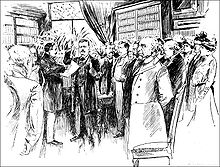John R. Hazel
John R. Hazel | |
|---|---|
 Judge Hazel swore-in Roosevelt as President | |
| Judge of the United States District Court for the Western District of New York | |
| In office June 5, 1900 – March 5, 1931 | |
| Appointed by | William McKinley |
| Preceded by | new seat |
| Succeeded by | John Knight |
| Personal details | |
| Born | December 18, 1860 Buffalo, New York |
| Died | October 31, 1951 (aged 90) |
John Raymond Hazel (December 18, 1860–October 31, 1951) was a United States jurist and politician, best known for administrating the presidential oath of office to Theodore Roosevelt. A resident of Buffalo, New York, he served as a federal judge from 1900 to 1931, and was also a delegate to the 1900 Republican National Convention (which nominated Roosevelt as its vice-presidential candidate.)[1]
Nomination controversy
Hazel was nominated as District Judge for the United States District Court for the Western District of New York by President William McKinley. The nomination was opposed by the Buffalo Bar Association, which considered him unfit for judgeship. A group of five lawyers went to New York City on the association's behalf for the purpose of meeting with the Association of the Bar of the City of New York to express their opposition. Contemporaneous accounts indicate that it was a dispute between Platt and anti-Platt rings then prevalent in New York.[2]
Administering the oath of office
On September 6, 1901 President McKinley was attending the Pan-American Exposition in Buffalo, New York when he was shot by Leon Czolgosz. Roosevelt was vacationing in Vermont, and traveled to Buffalo to visit McKinley in the hospital. It appeared that McKinley would recover, so he went on a planned family camping and hiking trip to Mount Marcy in the Adirondacks. In the mountains, a runner notified him McKinley was on his death bed. Roosevelt pondered with his wife, Edith, how best to respond, not wanting to show up in Buffalo and wait on McKinley's death. Roosevelt was rushed by a series of stagecoaches to North Creek train station. At the station, Roosevelt was handed a telegram that said President McKinley died at 2:30 AM, September 14, 1901. The new President continued by train from North Creek to Buffalo. He arrived in Buffalo later that day, accepting an invitation to stay at the home of Ansley Wilcox (now the Theodore Roosevelt Inaugural National Historic Site). It was there, on the afternoon of September 14, that Hazel administered the oath to Roosevelt.
Notable cases
In 1909, Judge Hazel issued an order cancelling the naturalization of Jacob A. Kersner, at the request of the U.S. Attorney's office, and thus stripping the citizenship of his ex-wife, the Anarchist orator Emma Goldman, who had gained U.S. citizenship in 1887 by her marriage to Kersner.[3] Ten years later, in 1919, the Wilson administration used Hazel's voiding of her citizenship as the basis for ruling that Goldman could be deported to Russia as an "alien anarchist," along with 248 other "undesirables," on the USAT Buford.
Judge Hazel heard the 1910-1913 lawsuit by the Wright brothers who alleged patent infringement against manufacturer Herring-Curtiss Company and inventor Glenn Curtiss. Hazel ruled in February 1913 for the Wrights, and on appeal a higher court agreed with this decision in 1914.[4] The decision was controversial for so favorably interpreting the uniqueness and priority of the technical achievements of the Wrights, and it has been argued that this broad interpretation of their intellectual property slowed aviation developments in the U.S.[5][6]
References
- John Raymond Hazel at the Biographical Directory of Federal Judges, a publication of the Federal Judicial Center.
- Morris, Edmund. The Rise of Theodore Roosevelt. Modern Library, 2001 (paperback edition). ISBN 0-375-75678-7.
- ^ Political Graveyard
- ^ "Lawyers Oppose Hazel's Appointment," New York Times (front page) (May 30, 1900)
- ^ "Emma Goldman Now Alien. Deprived of Rights of Citizenship by Disenfranchisement of Her Husband." New York Times, April 9, 1909, Page 2.
- ^ Head, James. 2008. Warped Wings. Mustang, Oklahoma, U.S.: Tate Publishing.
- ^ Shulman, Seth. Unlocking the Sky: Glenn Hammond Curtiss and the Race to Invent the Airplane. New York: Harper Collins, 2002. ISBN 0-06-019633-5.
- ^ Levine, David; Michele Boldrin (2008). Against intellectual monopoly. Cambridge University Press. ISBN 978-0-521-87928-6.
- 1860 births
- 1951 deaths
- Politicians from Buffalo, New York
- Presidency of Theodore Roosevelt
- Judges of the United States District Court for the Western District of New York
- United States federal judges appointed by William McKinley
- Assassination of William McKinley
- Lawyers from Buffalo, New York
- United States federal judges admitted to the practice of law by reading law
